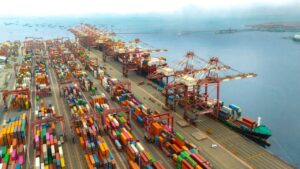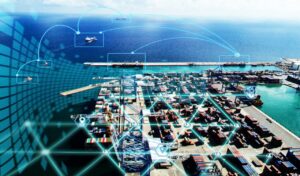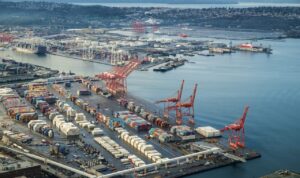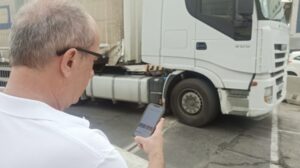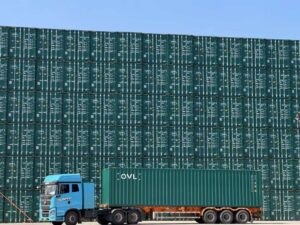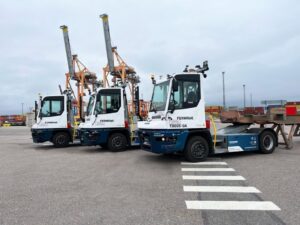Operatives at PSA Antwerp will conduct studies into dual fuel (hydrogen/diesel) straddle carriers as the terminal operator continues to seek to drive down emissions.
The terminal operator told PTI that a hydrogen-diesel dual fuel engine is an “excellent transition technology” for diesel-based straddle carriers, which can be retrofitted with the cells.
PSA Antwerp recently conducted a feasibility study at its Europa Terminal into a hydrogen-powered tractor in partnership with WaterstofNet, Terberg, and the Flanders Institute for Logistics (VIL).
Straddle carriers at the PSA Europa terminal produce the largest amount of carbon emissions – making the equipment the next target on the list to decarbonise from fossil fuels.
Retrofit benefits
“For PSA Antwerp, a dual-fuel (H2-diesel) technology for straddle carriers could be an excellent transition technology,” said Bart Paijmans, Project Leader of Engineering, and Wouter Vriens, Project Manager of Equipment at PSA Antwerp in a written statement to PTI.
The pair said that zero-emission hydrogen fuel cells can begin “as an independent add-on” to be used in retrofit onto equipment the terminal already has in operation.
“In a transition phase, new generation fuels and fuel additives also offer an opportunity to partially reduce emissions, as they can be used immediately and don’t require changes to our fleet,” Paijmans and Vriens said.
Similar successful demonstration will be a prerequisite for further testing of dual-fuel cell technologies, the pair said.
“If the demonstration is successful, we will try to gradually increase the hydrogen injection in the years to come. We will also set-up a fuel-cell straddle carrier demonstration with the aim to compare the performance of a hydrogen fuel cell with a retrofitted hydrogen combustion engine.
“Implementing successful demonstrations for our Green Straddle Carrier programme together with technology partners and port stakeholders would be a first great step,” the pair explained.
“We can use those lessons learned to share our knowledge and set up additional decarbonisation projects.”
Technology agnostic
In its quest for low-to-zero carbon solutions, PSA Antwerp Europa will continue to explore three options: electric, hydrogen, or alternative fuels such as ammonia or biofuels, Paijmans and Vriens said.
“At PSA Antwerp, we have not yet made a final technology down-selection. We are analysing a wide variety of potential green solutions,” they added.
When looking at green solutions, a plethora of factors including terminal layout, operational flexibility, cost efficiency, safety and maintenance activities have to be considered, the pair said – making investment strategies “a complex inquiry.”
PSA Antwerp believes there is no “off the shelf solution” for ports to reduce cargo-handling equipment emissions, meaning the terminal will move to a demonstration programme and investigate the three options in parallel.
“There is no one single solution to combat global warming and climate change, but possibly a combination of diverse solutions: renewable energies, carbon capture and utilization, circularity and hydrogen,” they said.
“Furthermore, new energy technologies (Energy Battery Storage Systems, Power-to-X, E-Fuels, and Sector Coupling) are still evolving as many have not yet reached their maturity level.”
Green hydrogen’s key flexibility
But Paijmans and Vriens noted that green hydrogen has its perks over other solutions.
Other pieces of low-or-zero emission cargo-handling equipment on the market “have some constraints” such as batteries having a limited life-span, or longer charging time, they explained.
Additionally, hard-to-abate sectors such as long and heavy-duty transport “are almost impossible to electrify”.
“In comparison, hydrogen has a much better energy/mass density and energy transfer rate, meaning a much faster filling process. Green hydrogen is an excellent energy carrier with no direct emissions of pollutants or greenhouse gases.
“Moreover, hydrogen is versatile. It can be transported as a gas by pipelines or in a liquid form. It can be transformed in electricity to feed an electric motor or a shore power system, or it can be used as an ingredient to produce synthetic fuels such as methanol and ammonia,” they said.


